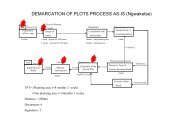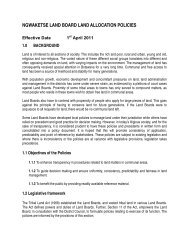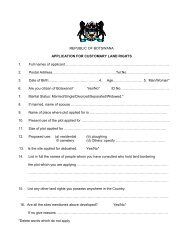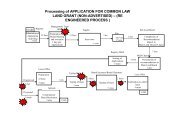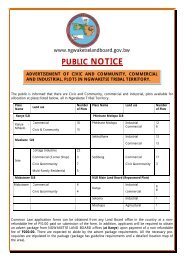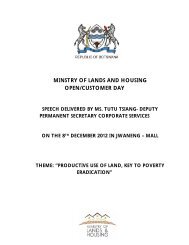District Intergrated Land Use Plan - Ngwaketse Land Board
District Intergrated Land Use Plan - Ngwaketse Land Board
District Intergrated Land Use Plan - Ngwaketse Land Board
You also want an ePaper? Increase the reach of your titles
YUMPU automatically turns print PDFs into web optimized ePapers that Google loves.
CHAPTER 2<br />
ADMINISTRATIVE AND INSTITUTIONAL ARRANGEMENTS<br />
the impending environmental impact assessment legislation (expected to be enacted), it<br />
would be mandatory for the environmental impacts of all activities to be mitigated through<br />
an environmental management plan for each activity that would be approved for<br />
implementation be it a policy, a plan, a programme or a project either initiated by the Local<br />
Authorities or non-governmental organisations, Community based organisations and Civil<br />
Society, the Community and Private Sector Developers.<br />
2.7 IMPACT OF RELEVANT PROGRAMMES AND PROJECTS ON THE<br />
DISTRICT’S ECONOMY, LAND AND NATURAL RESOURCES<br />
2.7.1 The review of the achievements of the immediate past <strong>District</strong> Development <strong>Plan</strong> 5 period<br />
indicates that prioritised programmes and projects were either not completed or<br />
implemented at the expected rate, and hence did impact negatively on the <strong>District</strong>’s<br />
economy, land use and the natural resource base. Some of the major programmes and<br />
projects, which impacted on the <strong>District</strong> economy are as highlighted.<br />
2.7.2 Physical Infrastructure: Roads: In the Southern <strong>District</strong>, road transport is a vital and<br />
necessary infrastructure to meet the basic need of mobility and a necessary condition to<br />
promote the <strong>District</strong>’s economic development. The target of the past 5th Development <strong>Plan</strong><br />
period was to provide reliable access to communities and to areas with economic potential<br />
and supporting decentralisation of services by improving or upgrading the external road<br />
network and strengthening the implementation capacity for development and maintenance<br />
of roads. In terms of accessibility 62 out of 83 villages (with Primary Schools) could be<br />
accessed by tarred or gravelled road. The re-construction of the Jwaneng – Sekoma road<br />
(part of the Trans-Kalahari Road), the Lobatse – Kanye By-pass and the fencing of the<br />
Kanye – Ramatlabama road, and the Mogobane – Ranaka road that were planned for<br />
completion during the past plan period have spilled into the current plan period. This major<br />
road infrastructure would boost the <strong>District</strong>’s economy in terms of facilitating the movement<br />
of people, goods and services within and through the <strong>District</strong>. Whilst the <strong>District</strong> has made<br />
tremendous efforts in making linkages between villages possible by either gravel or graded<br />
roads, the maintenance of the infrastructure lacks manpower as well as the financial<br />
resources and limited equipment.<br />
2.7.3 Telecommunication: The on-going telecommunication network project in the Barolong areas<br />
including <strong>Ngwaketse</strong> West is expected to also impact positively on the <strong>District</strong>’s economy.<br />
2.7.4 Housing: Evidence based on the 2001 Census reveals that 3 out of every 10 households in<br />
the <strong>District</strong> still use traditional building materials (mud, poles, and thatch) hence impacting<br />
negatively through deforestation, biodiversity loss, land degradation and natural resources<br />
depletion. In general, housing delivery is short of supply creating a perpetual inadequacy<br />
especially for the <strong>District</strong> Council, <strong>Land</strong> <strong>Board</strong>s, Tribal and <strong>District</strong> Administration.<br />
Inadequate housing has grown also due to decentralisation of operations to Sub <strong>District</strong><br />
levels. Housing delivery is constrained by uncoordinated and proliferation of settlement that<br />
make provision of infrastructure and social services difficult and expensive.The poor<br />
housing market in the <strong>District</strong> is also a deterrent to attract the private sector to invest and<br />
provide private and rental housing. In 2001, Self Help Housing Agency (SHHA) was<br />
introduced to Southern <strong>District</strong>. There is a total of 21 settlements that are currently covered<br />
under the programme. The number of applications approved between 2001 and 2003<br />
totalled 292. This programme is bound to have a spin-off effect on housing in the<br />
foreseeable future.<br />
2.7.5 Water Infrastructure: Improving the reliability of village water supply systems impacts<br />
22 REPORT OF SURVEY



